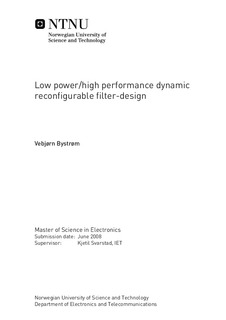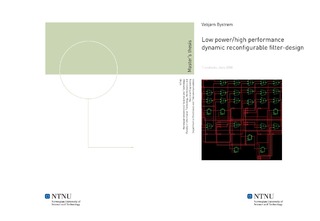| dc.contributor.advisor | Svarstad, Kjetil | nb_NO |
| dc.contributor.author | Bystrøm, Vebjørn | nb_NO |
| dc.date.accessioned | 2014-12-19T13:43:34Z | |
| dc.date.accessioned | 2015-12-22T11:41:10Z | |
| dc.date.available | 2014-12-19T13:43:34Z | |
| dc.date.available | 2015-12-22T11:41:10Z | |
| dc.date.created | 2010-09-03 | nb_NO |
| dc.date.issued | 2008 | nb_NO |
| dc.identifier | 347639 | nb_NO |
| dc.identifier.uri | http://hdl.handle.net/11250/2369137 | |
| dc.description.abstract | The main idea behind this thesis was to optimize the multipliers in a finite impulse response (FIR) filter. The project was chosen because digital filters are very common in digital signal processing and is an exciting area to work with. The first part of the text describes some theory behind the digital filter and how to optimize the multipliers that are a part of digital filters. The substantial thing to emphasize here is the use of Canonical Signed Digits (CSD) encoding. CSD representation for FIR filters can reduce the delay and complexity of the hardware implementation. CSD-encoding reduces the amount of non-zero digits and will by this reduce the multiplication process to a few additions/subtractions and shifts. In this thesis it was designed 4 versions of the same filter, that was implemented on an FPGA, where the substantial and most interesting results were the differences between coefficients that was CSD-encoded and coefficients that was represented with 2's complement. It was shown that the filter version that had CSD-encoded coefficients used almost 20% less area then the filter version with 2's complement coefficients. The CSD-encoded filter could run on a maximum frequency of 504,032 MHz compared the other filter that could run on a maximum frequency of 249,123 MHz. One of the filters that was designed was designed using the * operator in VHDL, that proved to be the most efficient when it came to the use of number of slices and speed. The reason for this was because an FPGA has built-in multipliers, so if one has the opportunity to use the multiplier they will give the best result instead of using logic blocks on the FPGA It was also discussed a filter that has the ability to change the coefficients at run-time without starting the design from the beginning. This is an advantage because a constant coefficient multiplier requires the FPGA to be reconfigured and the whole design cycle to be re-implemented. The drawback with the dynamic multiplier is that is uses more hardware resources. | nb_NO |
| dc.language | eng | nb_NO |
| dc.publisher | Institutt for elektronikk og telekommunikasjon | nb_NO |
| dc.subject | ntnudaim | no_NO |
| dc.title | Low power/high performance dynamic reconfigurable filter-design | nb_NO |
| dc.type | Master thesis | nb_NO |
| dc.source.pagenumber | 99 | nb_NO |
| dc.contributor.department | Norges teknisk-naturvitenskapelige universitet, Fakultet for informasjonsteknologi, matematikk og elektroteknikk, Institutt for elektronikk og telekommunikasjon | nb_NO |

